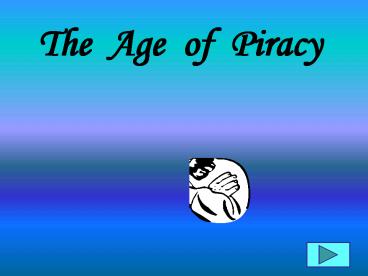The Age of Piracy - PowerPoint PPT Presentation
1 / 14
Title:
The Age of Piracy
Description:
... up to the mighty Spanish Armada, empires gave license to privately ... failed and returned to England in time to help defeat the Spanish Armada in 1588. ... – PowerPoint PPT presentation
Number of Views:46
Avg rating:3.0/5.0
Title: The Age of Piracy
1
The Age of Piracy
2
Before the discovery of the Americas, most piracy
took place in the Atlantic Triangle. This was a
group of three islands off the coast of Spain and
Africa the Canary Islands, the Madeiras, and
the Azores.
In the 16th and 17th centuries, however, piracy
took up residence in the Caribbean.
3
Causes of Piracy
The Spanish held a monopoly over trade in the
Caribbean. They were the only country with
colonies and would allow no other empire to trade
with them. However, other empires wanted to
trade with Spanish colonies, and so illegal
trading led to piracy and raiding.
4
Spanish explorers had discovered the Aztec and
Incan empires. With the discovery of these
empires came massive amounts of gold and treasure
that were being shipped across the Atlantic in
the Spanish Flota a large convoy of Spanish
ships.
The only access other countries had to this gold
and treasure was to take it forcefully Jean
Florin in 1523 captured the treasure of Montezuma
which contained gold, sugar, pearls, and tobacco.
5
Pirates not only wanted treasure, they also
wanted new ships. Ships did not last long in the
warm Caribbean waters because they were made of
wood and rotted easily and quickly. So, most of
the time pirates commandeered ships as well as
stole treasure.
6
Because the Spanish style of colonization was not
entirely effective in each place they discovered,
many islands were left abandoned and uninhabited.
These uninhabited islands became safe havens for
pirates and perpetuated the existence of piracy.
They also became the permanent residence for
runaway slaves and army deserters. These two
populations were known as buccaneers.
Two of the most famous of these pirate havens
were the islands of Tortuga (off the coast of
Haiti) and Jamaica.
7
Participants in Piracy
During this time in the 16th and 17th centuries,
the empires of Europe were constantly at war with
Spain.
Unable to stand up to the mighty Spanish Armada,
empires gave license to privately funded ships to
attack the Spanish. These privately funded men
were known as privateers.
These privateers were pirates, in that, they
attacked and raided ships from other empires, for
the benefit of their own empire as well as
themselves. There were also normal pirates, not
funded by anyone, who raided only for themselves.
Most of these privateers were called gentleman
pirates. Many of them were also protestant,
which fueled their animosity towards Catholic
Spain even more.
8
Sir Francis Drake A Story of an English Gentleman
Pirate
Sir Francis Drake moved into the Caribbean in
1572 with 70 men and 2 ships.
He made contact with the runaway slaves in
Panama, and together, they attacked the Spanish
silver mule train from Peru and were very
successful.
Drake used this money to fund a voyage around the
world. In 1585 he tried to take the Caribbean
for England with 20 ships and 2,500 men, but he
failed and returned to England in time to help
defeat the Spanish Armada in 1588.
9
(No Transcript)
10
Piet Hein A Story of a Dutch Gentleman Pirate
Pirates were also funded by joint-stock
companies companies in which there are many
investors. Piet Hein was funded by the Dutch
West India Company.
In 1626, he captured the entire Spanish treasure
fleet and took it to Amsterdam. This caused the
dividends of investors to increase by 50, and
made The Netherlands a very wealthy empire.
11
The End of Piracy
By the 1650s, Spain realized that they could not
supply all the goods their colonies needed. They
made it so that all other empires could trade
with Spanish colonies so long as they had a
partner in Seville, the capital of Spain.
Other empires also started moving against pirates
or privateers who did not have license from the
government, and who were raiding during peace
time.
By the 1670s, with more legal means of trading,
only 1/3 of all the goods going to the colonies
were from Spain.
12
Spain began losing control of the Caribbean
around the 1650s, and other empires began
founding colonies and claiming lands.
After 1700, many famous pirates were killed or
captured, like Blackbeard the pirate.
From 1713 to 1726 there was a period of peace
between European powers.
The empires begin moving more aggressively
against pirates, making even association with one
a crime.
13
After 1730, most pirates moved to the South
Pacific to continue their raiding and plundering.
14
113.33. World History Studies
(c) Knowledge and skills. (5) History. The
student understands causes and effects of
European expansion beginning in the 16th
century. The student is expected to
(A) identify causes of European expansion
beginning in the 16th century








![[PDF READ] Free Buccaneers of the Caribbean: How Piracy Forg PowerPoint PPT Presentation](https://s3.amazonaws.com/images.powershow.com/10117946.th0.jpg?_=20240902075)
![[PDF] Villains of All Nations: Atlantic Pirates in the Golden Age (Beacon Classics) (PDF) PowerPoint PPT Presentation](https://s3.amazonaws.com/images.powershow.com/10119825.th0.jpg?_=202409040612)












![READ [PDF] Under the Black Flag: The Romance and the Reality PowerPoint PPT Presentation](https://s3.amazonaws.com/images.powershow.com/10112773.th0.jpg?_=20240830072)








